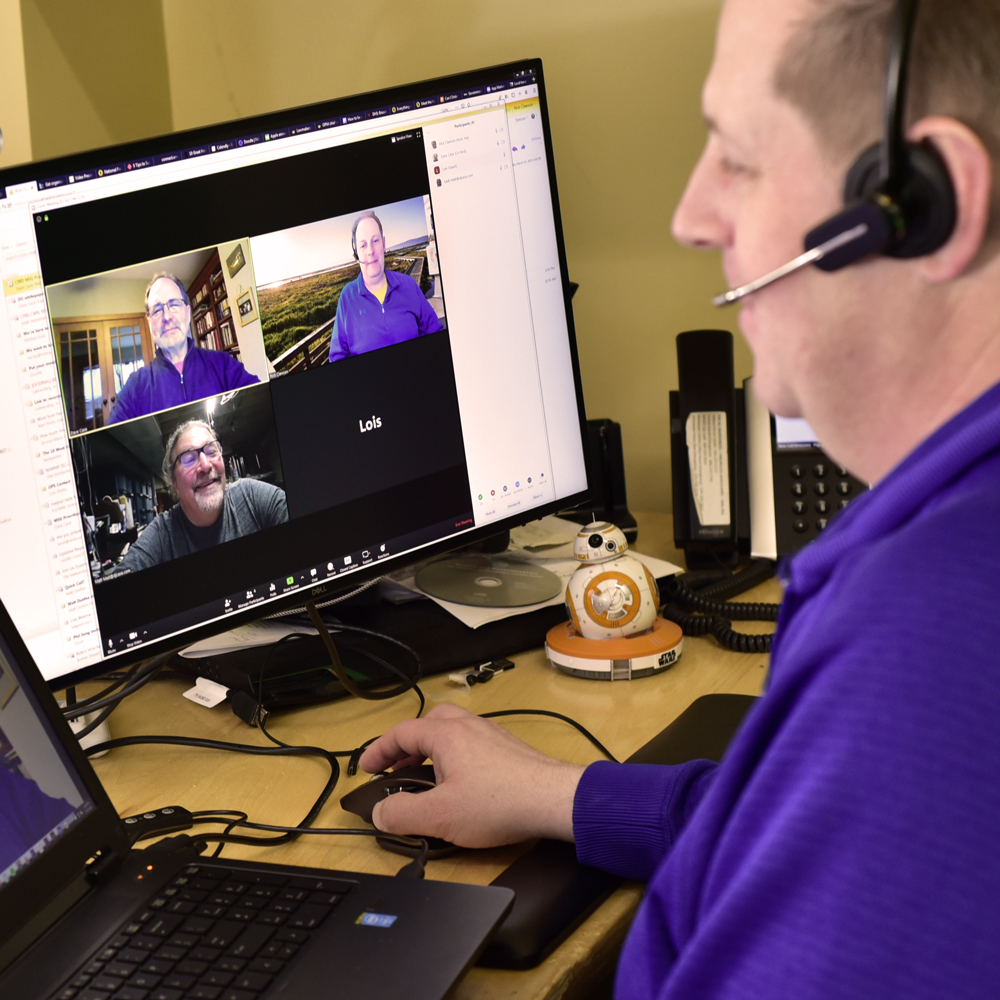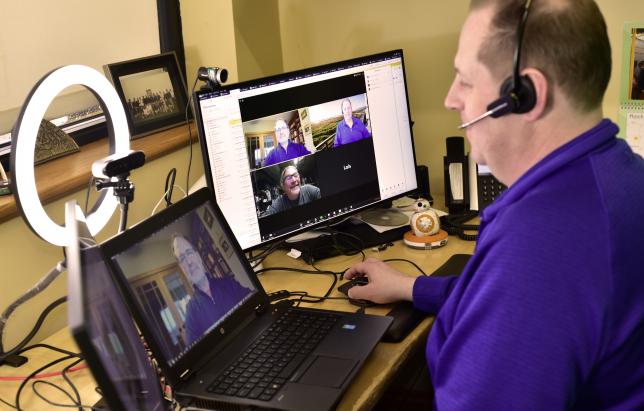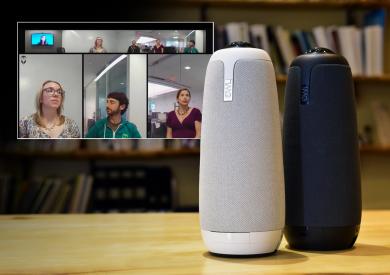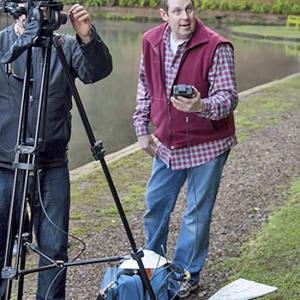
How to be social at a distance

Multimedia specialist Rick Clawson video conferences with Dave Case and Matt Harlow. Rick frequently makes use of a ring light and positions his webcam so that he can look participants "in the eye" when addressing them.
As conservation communicators, we place a high value on getting together to collaborate on large-scale and long-term natural resource challenges. Nothing beats hearty handshakes, friendly embraces, and face-to-face exchange — except when pandemics strike and budget cuts loom.
The alternative — conference calls and screen shares — can easily come up short. Sure, we all want to flatten the curve, but we don’t want to squash our team’s progress or turn off our audiences in the process.
At DJ Case, we have tried and tested lots of tech. And we have used social science approaches to stack up techniques for remote meetings and collaboration. Here are just a few things you can consider to make your online meetings more effective:
Pick a platform

For many years, we relied on Adobe Connect. It was solid, stable, and loaded with features. Lately, we rely on Zoom. It’s easy to use and light on bandwidth but still has sharp video. It offers integrated phone options and live screen-share — and it’s much less expensive overall. Both allow you to record your meetings to keep an accurate record or to share with co-workers who are taking care of sick kids at the time of your virtual meeting.
There is no shortage of options — Skype, Google Hangouts, WebEx and others. If you’re connecting with a small team over brief periods, free Google Hangouts will do the job. Zoom’s free account will allow meetings up to 40 minutes, too. If you need to connect with more people, look toward paid, enterprise-level products like Adobe Connect or Zoom. As a bonus, this technology uses your Internet connection to carry the audio, so your attendees won't have to use their cell phones or "mythical" home land lines to dial in.
Mass engagement
If your online engagement is wide-reaching (like last week’s Migratory Bird Treaty Act rulemaking webinars), you may want some professional support. Most online meetings support up to 100 participants out of the box, but they can also be expanded nearly as much as you need. We have the capacity to support up to 1,000 online participants. So, if you wanted to conduct a big public outreach effort, or take that summit or symposium online, we’ve got it covered. We can even set you up with webinar rooms for up to 10,000! The bigger your audience, the more you should consider “production-level” planning and support to ensure your audience is engaged, your message is sound, and your collaboration is effective.
No static at all
(Yes, that is an unapologetic Steely Dan reference)
The quality of the audio in a video conference really counts. Don’t skimp on sound. You have probably been on calls where static-y, crumbly, or low-volume audio made you lunge your cursor toward the disconnect icon. Perhaps even worse — you turned down the volume and wandered off to check your email, browse the CDC website for the latest pandemic news, or see what Facebook friends are up to.
Try to ensure that all of your participants have good connections and audio inputs. If you are a primary presenter or facilitator, it’s critical to come through loud and clear. Get yourself a good headset (headphones and mic) – wired or wireless. Having a good microphone close to your mouth will minimize background noise. Quality headphones (single ear or double) will help you listen to others, even if they aren’t as well equipped with a good mic on their end. Don’t want to wear a mic? There are good quality, relatively inexpensive tabletop mics, too. Put the mic close to pick up sound right around you.
Lights. Camera . . .
Video conferencing should be your default setting.
People quite literally shy away from sharing their camera feed and showing their faces, but there’s good reason to make camera-sharing an expectation. Once cameras come on, the entire etiquette and atmosphere of online meetings changes. Participants are less likely to zone out or multitask.
Let your participants know ahead of time that they should have cameras positioned and be ready to show their faces. They are apt to feel more comfortable if they have time to prepare for the sharp glare of the lime . . . er, uh, LED light.
Once cameras come on, the entire etiquette and atmosphere of online meetings changes. Participants are less likely to zone out or multitask.

Using a simple green screen curtain as a backdrop, Rick Clawson gives the illusion that he is outside and not quarantined in his office.
Consider positioning your camera so that you can make virtual eye contact with participants. The result will be cut-above levels of closeness and engagement with your team/audience. Being on camera – and having a good camera on your computer system – means you can go a long way toward replicating the high-value, face-to-face experience.
While the built-in camera on your laptop or screen will work, spending a little bit to get a decent HD external camera ($50-100) will give you more options to position the camera in a better place for better framing – so everyone isn’t looking up your nose from below or from some odd position off to the side.
And as for video, it doesn’t take much to improve the look of your video – adding a small LED ring light to the setup ($20-50) can help provide a little light on your face so you look less like you’re in a cave. Standard overhead lighting is not flattering, windows or other bright items in the background can make you look backlit, etc. All these things can be distracting, so taking a little time to work on the camera position and framing, adding some light, and adjusting what’s in your background can add a lot to your online look and presence, making it easier for others to see you and connect with and read each other’s facial expressions.
Who cooks for you? Who cooks for you-all?

Owls in their natural habitat, the DJ Case conference room.
If some of your remote meeting participants are gathered together in one room (but still adequately distanced to avoid the spread of COVID-19!), you might want to consider a cool tool like the Owl camera. Like its feathered, Stringeformes namesake, it has binaural hearing and vision that can span a whole room (though it does lack sharp talons and night vision).
This Owl is high-def with a full 360-degree camera, built-in mics, and speakers. It has a nearly magical owl-like ability to see who’s sitting where. It automatically zooms in on the person or people actively speaking. You'll still need Zoom or some other conferencing software to share the meeting with off-site participants, but they'll really feel like they are a part of the meeting.
We could go on
There’s always more we could dig into on this topic (and we probably will later). Depending on the size of your audience and your objectives, there are a whole array of tools and techniques you can use to make online meetings effective, to save time, and to truly engage with people to achieve conservation success.
What do you do that works for virtual meetings?
- Enlist your participants with jobs to do
- Involve everyone through periodic temperature checks and surveys
- Consider ways to get your meetings mobile and your participants outside!
Ultimately, online meetings aren’t hard to conduct and conduct well. With a few tech and technique tweaks, you can connect and collaborate with your teams in many of the same ways you would in-person, just without all the travel expense and virusy concerns.
We have a team of facilitators who can bring tech and social science expertise to your next public meeting, committee process, or webinar. Contact me (Rick Clawson) or Matt Harlow to explore ideas.
DJ Case makes no endorsement of, nor have we received any compensation from, the products and services mentioned here. We are influencers, but not for products. We advocate for wild things and wild places.
March 21, 2020
